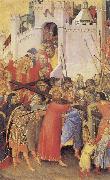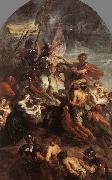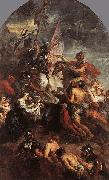
|
Maurice Denis
|
|||
|
|
|||
| 1870-1943 French Maurice Denis Locations | |||
|
|
|||
| This artist (Maurice Denis) is not available now. | |||
|
|
|||
|
Simone Martini
|
|||
|
|
|||
| 1283-1344 Italian Simone Martini Locations | |||
|
|
|||
|
El Camino a Calvario new9/Simone Martini-948229.jpg Pintura Identificación:: 33318 |
mk86 C. 1315 Témpera en la madera 29.5x20.5cm París, Musee du Nacional Louvre | ||
|
|
|||
|
RUBENS, Pieter Pauwel
|
|||
|
|
|||
| Flemish Baroque Era Painter, 1577-1640 | |||
|
|
|||
|
The Road to Calvary new21/RUBENS, Pieter Pauwel-532939.jpg Pintura Identificación:: 63958 |
1634-37 Oil on canvas, rounded at the top, 569 x 355 cm Musees Royaux des Beaux-Arts, Brussels This painting was commissioned in 1634 for the high altar of the Abbey of Affligem, then one of the most important monasteries in the Low Countries. Tensions inside the monastery may explain why this monumental work was not delivered until 1637. In this production of his mature period, Rubens masterfully combines two artistic traditions. The first of these is that of the large single-frame altarpieces that were to replace the older polyptychs in the Southern Low Countries in the 17th century. With their exceptional scale and their strongly vertical format, they faced artists with the problem of constructing a convincing compositional unity from a series of related themes in a vertical format. As an artist gifted with one of the greatest compositional and narrative talents of his age, Rubens fulfilled his task masterfully. Instead of dividing the painting into an upper and lower register, a solution that he had often applied following Titian, he elects here to represent Christ's ascension to the place of his execution on Calvary in an uninterrupted zigzag movement. The thrust from below to above is achieved both in the colouring, with a balanced rhythm of localised concentrations of colour, and also iconographically, with the successive tableaux of the executioners with the two thieves, the holy women with Mary and Veronica, and ending with the Roman officers on horseback with their flapping pennants. The centre-point of the composition is Christ's face that St Veronica is wiping. Turned towards the viewer, it forms a direct call to the faithful to follow his life and to think on their own sins that had to be redeemed by Christ's suffering. This procedure descends directly from the tradition of devotional art, with small-scale pictures intended for individual meditation. The genius of Rubens' invention lies precisely in the combination of the two pictorial traditions, breathing new life into the ancient devotional tradition within a contemporary, counter-reformation form of altar decoration, whilst at the same time enriching the broad, sweeping movement of such a monumental high altarpiece with the more intimate emotionality of smaller devotional paintings. , Artist: RUBENS, Pieter Pauwel , The Road to Calvary , 1601-1650 , Flemish , painting , religiou | ||
|
|
|||
|
Peter Paul Rubens
|
|||
|
|
|||
| Flemish Baroque Era Painter, 1577-1640 | |||
|
|
|||
|
The Road to Calvary new24/Peter Paul Rubens-599464.jpg Pintura Identificación:: 83528 |
Date between 1634(1634) and 1637(1637) Medium Oil on canvas, rounded at the top Dimensions Height: 569 cm (224 in). Width: 355 cm (139.8 in). cjr | ||
|
|
|||
|
Giovanni Sodoma
|
|||
|
|
|||
| 1477-1549 Giovanni Sodoma Galleries | |||
|
|
|||
|
The Road to Calvary new24/Giovanni Sodoma-397875.jpg Pintura Identificación:: 83574 |
Date ca. 1510(1510) Medium Oil on wood Dimensions Height: 36.5 cm (14.4 in). Width: 62 cm (24.4 in). cjr | ||
|
|
|||
|
Also Buy::. For Following Paintings / Artists / Products, Please Use Our Search Online: |









